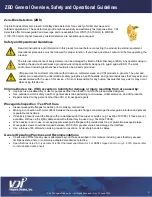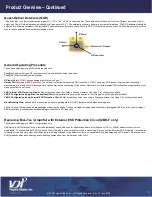
6
© 2020 Virginia Diodes, Inc.
—All Rights Reserved—Rev: 12 June 2020
ZBD (Internal ESD Protection)
Standard ZBD configuration
ZBD-F (Fast Detector)
†
Standard ZBD-F configuration includes 6 GHz bias-tee and amplifier.
Fast Detector Technical Notes:
*Fast Detectors are shipped with a 6 GHz bias-tee and amplifier attached to the detector unless other options are specified. Additional fast detector options are
shown in the table above and can be purchased at an additional cost. Contact VDI for more information.
*Amplifiers included in the F06, F20, and F40 options have a 50 ohm input impedance. The amplifier included in the FDA option has a high input impedance. The
total gain or loss through the ZBD-F (detector, bias-tee and amplifier) will depend on the output impedance of the ZBD and the input impedance of the amplifier.
Impedance mismatch will reduce the signal out of the amplifier. The amplifier included in the FDA option is better matched with the ZBD compared to the other
amplifier. Therefore, there will be less signal degradation through the amplifier included in the FDA option compared to the other amplifiers.
*Amplifier gain performance assumes correct testing conditions (bias voltage, input impedance, output impedance) specified in the above table.
Fast Detector Options
Fast
Detector
Option
Frequency Range
Gain (dB, typical)
Bias Voltage
Input
Impedance
Output
Impedance
ZBD-FDA
~2 kHz to 40 MHz
40
+5 V (~50mA)
High Impedance
50
Ω
ZBD-F06
~50 MHz to 6 GHz
15
+5V (~80mA)
50
Ω
50
Ω
ZBD-F20
~ 100 MHz to 20 GHz
12
+12V / -5V (~80mA)
50 Ω
50 Ω
ZBD-F40
~50 MHz to 40 GHz
10
+5 V (~100mA)
50
Ω
50
Ω
Configurations (ZBD vs. ZBD-F)
External ESD Protection Circuit Output:
DC to ~250 kHz
~0.5-1k
Ω Output Impedance
Provides ESD Protection
Output:
DC to ~250 kHz
~3-
6kΩ Output Impedance
No access to full detector response rate
Provides ESD Protection
External components can be removed to access
full detector frequency response rate.
Detector Output Port Extremely ESD Sensitive
See Maximum Detector Response Rate on Page 7
RF Input
RF Input
DC Bias Connections
Amplifier
Bias-Tee
Output
External ESD Protection Circuit












